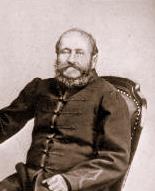Imre Frivaldszky: Difference between revisions
authority control moved to wikidata |
|||
| Line 20: | Line 20: | ||
* [http://www.nhmus.hu/users/foldvari/balint_no_150.pdf Bálint Zs. and S Abadjev: ''An annotated list of Imre Frivaldszky’s publications''. Annales Historico-Naturales Musei Naturalis Hungarici 98:185,2006]. |
* [http://www.nhmus.hu/users/foldvari/balint_no_150.pdf Bálint Zs. and S Abadjev: ''An annotated list of Imre Frivaldszky’s publications''. Annales Historico-Naturales Musei Naturalis Hungarici 98:185,2006]. |
||
{{Authority control |
{{Authority control}} |
||
{{Persondata <!-- Metadata: see [[Wikipedia:Persondata]]. --> |
{{Persondata <!-- Metadata: see [[Wikipedia:Persondata]]. --> |
||
Revision as of 03:55, 4 May 2015

Dr Emerich (Imre) Frivaldszky von Frivald (6 February 1799, Bacskó, Hungary, now Slovakia - 19 October 1870, Jobbágyi, Hungary) was a Hungarian botanist and entomologist.
Biography
Born into a family of landed gentry,[1] Frivaldszky studied at the gymnasiums in Sátoraljaújhely and Eger, then philosophy at the Royal Academy of Kassa. He graduated in medicine from the University of Budapest in 1823. While still a student in Eger he accompanied Pál Kitaibel and Jószef Sadler on botanical excursions. By the time he graduated in medicine he was already assistant curator at the Hungarian National Museum in Budapest in 1822, where he later served as curator until his retirement in 1851. In 1824 he abandoned the practice of medicine and spent the rest of his life as a botanist and zoologist. He made many collecting trips throughout Hungary (including present day Slovakia and the Banat), Bulgaria, Turkey and Italy.[2]
Frivaldszky wrote extensively on plants, snakes, snail and especially insects (Lepidoptera and Coleoptera).[3] A large part of his huge entomological collection was destroyed in a flood in 1838, the rest in 1956 during the anticommunist revolution. Many of his specimens are in the Museo storia naturale di Pisa.
Notes
- This article includes material from the Slovak and Hungarian Wikipedia.
